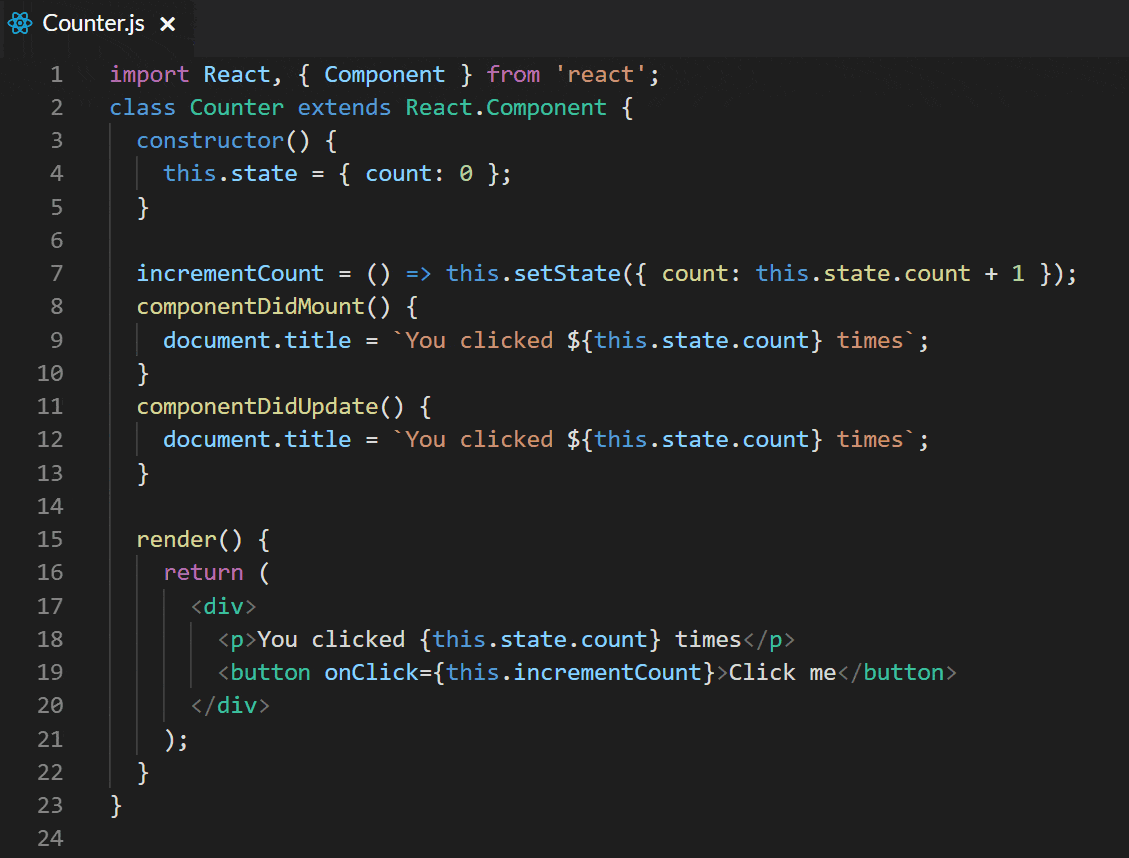Understanding React Hooks: A Comprehensive Guide
React Hooks are one of the most powerful and popular features introduced in React 16.8. They allow developers to use state and other React features in functional components without the need for writing class components. Hooks simplify the codebase, enhance reusability, and make React development more intuitive.

What Are React Hooks? Hooks are special functions that let you "hook into" React features such as state and lifecycle methods directly in functional components. Commonly used hooks include:
- useState
- useEffect
- useContext
- useRef
- useReducer
- useMemo
- useCallback
** Key React Hooks Explained
- useState: For Managing State
- The useState hook allows you to add state to a functional component.
Example:
javascript
Copy code
import React, { useState } from "react";
function Counter() {
const [count, setCount] = useState(0);
return (
<div>
<p>Current Count: {count}</p>
<button onClick={() => setCount(count + 1)}>Increment</button>
</div>
);
}
- useEffect: For Side Effects The useEffect hook is used for performing side effects such as fetching data, updating the DOM, or subscribing to events.
Example:
javascript
Copy code
import React, { useState, useEffect } from "react";
function Timer() {
const [seconds, setSeconds] = useState(0);
useEffect(() => {
const interval = setInterval(() => {
setSeconds((prev) => prev + 1);
}, 1000);
return () => clearInterval(interval); // Cleanup
}, []);
return <p>Elapsed Time: {seconds} seconds</p>;
}
3. useContext: For Managing Context The useContext hook makes it easier to consume context without needing to wrap components in a consumer.
Example:
javascript
Copy code
import React, { useContext, createContext } from "react";
const UserContext = createContext();
function UserProfile() {
const user = useContext(UserContext);
return <p>Welcome, {user.name}!</p>;
}
function App() {
const user = { name: "Alice" };
return (
<UserContext.Provider value={user}>
<UserProfile />
</UserContext.Provider>
);
}
useRef: For Referencing DOM Elements The useRef hook is useful for directly accessing and interacting with DOM elements or storing mutable values.
Example:
javascript
Copy code
import React, { useRef } from "react";
function InputFocus() {
const inputRef = useRef();
const focusInput = () => {
inputRef.current.focus();
};
return (
<div>
<input ref={inputRef} type="text" placeholder="Focus me!" />
<button onClick={focusInput}>Focus Input</button>
</div>
);
}
*useReducer: *For Complex State Logic The useReducer hook is an alternative to useState for handling more complex state transitions.
Example:
javascript
Copy code
import React, { useReducer } from "react";
const initialState = { count: 0 };
function reducer(state, action) {
switch (action.type) {
case "increment":
return { count: state.count + 1 };
case "decrement":
return { count: state.count - 1 };
default:
throw new Error();
}
}
function Counter() {
const [state, dispatch] = useReducer(reducer, initialState);
return (
<div>
<p>Count: {state.count}</p>
<button onClick={() => dispatch({ type: "increment" })}>+</button>
<button onClick={() => dispatch({ type: "decrement" })}>-</button>
</div>
);
}
*useMemo and useCallback: *For Performance Optimization
*useMemo: *Memorizes expensive calculations. useCallback: Memorizes functions to prevent unnecessary re-renders. Example:
javascript
Copy code
import React, { useState, useMemo, useCallback } from "react";
function ExpensiveCalculation({ num }) {
const calculate = useMemo(() => {
console.log("Calculating...");
return num * 2;
}, [num]);
return <p>Calculated Value: {calculate}</p>;
}
function App() {
const [count, setCount] = useState(0);
const [num, setNum] = useState(5);
const increment = useCallback(() => setCount(count + 1), [count]);
return (
<div>
<button onClick={increment}>Count: {count}</button>
<ExpensiveCalculation num={num} />
</div>
);
}
**Rules of Hooks
- Call Hooks at the Top Level
- Do not call hooks inside loops, conditions, or nested functions.
- Only Call Hooks in React Functions
- Hooks should be used in React functional components or custom hooks.
Custom Hooks
- Custom hooks are user-defined hooks that allow you to extract and reuse stateful logic across components.
Example:
javascript
Copy code
function useWindowWidth() {
const [width, setWidth] = useState(window.innerWidth);
useEffect(() => {
const handleResize = () => setWidth(window.innerWidth);
window.addEventListener("resize", handleResize);
return () => window.removeEventListener("resize", handleResize);
}, []);
return width;
}
function App() {
const width = useWindowWidth();
return <p>Window Width: {width}px</p>;
}
Conclusion
React Hooks have revolutionized how developers write React applications. By replacing class components with functional components and simplifying state management, lifecycle methods, and reusability, hooks have become an essential tool for modern React development. Start exploring hooks today and experience the difference they bring to your coding journey!







